|
|
| 
|
stylus | 2010-2011
Shahrokh Yadegari, Composer/Sound Designer
The Pulitzer Foundation for the Arts
St. Louis, Missouri
July 9, 2010-January 22, 2011
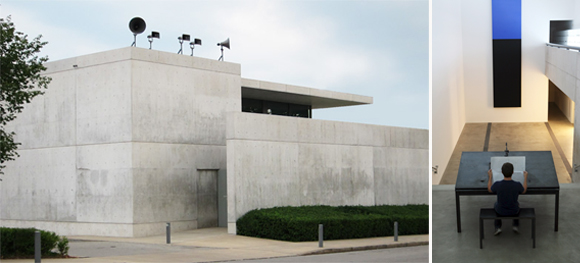
Materials: 2 player pianos; 26 channel speaker and sound system; fabric; 5 rolling ladders; 5 spinning projector mechanisms; steel table with moveable, amplified surface; steel ball bearings; 1500 paper hands; custom shelving unit; taxidermic birds; jumping beans; 2 record players; records and books from St. Louis Public School Archives; 5 rooftop mounted speakers; video; sound; light
For an in-depth look at stylus, please see the project website here.
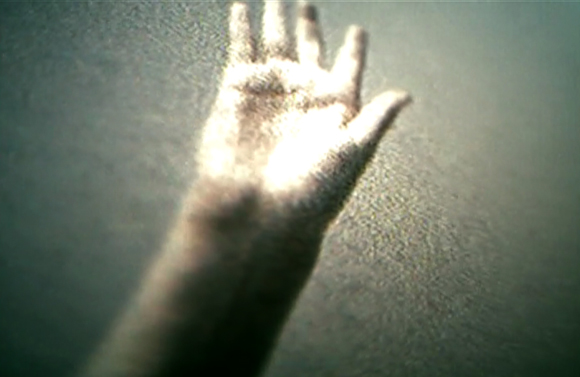
A Description
The changing weather of natural light moving across the interior volume of the Pulitzer formed my first experience of the space. Light is the central animating figure of the architecture; it falls across the walls as tangibly as a hand draws a line's path. In the main gallery, the surface of the adjacent water court angles the sun's reflections up and across the vertical volume, while the horizontal steps that divide the space to form a staircase and amphitheatre descend into shadow. There, an absent congregation faces the central location and singular geometry of the permanently installed Ellsworth Kelly, Blue Black, its vertical panel occupying the site where a cross is placed in a church apse. Although the line between the blue above and the black below is hard-edged, its binary form tethers it to dualities—categorically abstract and physically tangible— whose boundaries are less clearly drawn: the thick horizon of time where daylight and darkness meet, the line between form and formlessness, between what is knowable and what is unknowable. Like all edges where two surfaces meet, contact pivots around dichotomous relations: the membrane where my body leaves off and yours begins, an inside to a outside, dark to light, and speech to silence.
Thickening and probing the friction where two categories or two surfaces meet and touch erodes the habits of our naming and works an edge's connective tissue. The placement and visual structure of Blue Black evoke sacred and secular narratives, which twine word and light. I began to think not only about light, tangible to experience but impossible to hold in one's hand, but also about sound and voice, whose vibrations are similarly felt but out of reach. The hand offered and the hand taken away, Orpheus's lyre and Eurydice's severed hand, the act of turning to a past and toward a future.
How might a project amplify the presence of what is given to link the building's interior state of reflection and contemplation to the world outside its opaque walls? What is the relation of the intentional hollow of the galleries to a neighborhood, once vibrant with gatherings to worship, perform, sing, and dance together, and now partially emptied? How do we reach across these two cavities—one deliberately formed and one evolved from the consequence of social change? How might a project become a platform for collective vocalizations and assembly in a secular time? Can a sanctuary and a laboratory co-exist? How can the space become a site of reception and transmission? In an age of individual technological amplification and extension, how is contact embodied?
These were my questions.
The primary acts of bodily extension—the hand to touch and the voice to space—a place to begin. Turning between a tactile proximity and an aural distance, I began to think about the gesture of a hand raised to signal departure or welcome, recognition or attention, about the responsibility of the hand's ability to shape and the voice's to appeal. A morning paper arrives. A hand gathers and delivers the world of events with the flip of the wrist and the release of the fingers. Though impossible to trace what is read, what remains unread, or to account for the reverberation of each line or story, the arrival of the paper registers a distance crossed.
The Pulitzer is entered through double glass doors that open into a low-ceilinged gallery. Here, a pencil, a pad of paper, a shelf of books and records, a stack of newspapers—all tools of silent or sounded writing and reading from a pre-digital world—are set, like a legend on a map, in a concentrated form of stylus's potentials and relations. When signed, the paper pad on the glass reception desk registers a graphite signature; the pressure of the contact translates into the handless playing of a Disklavier piano, which sounds from a distant gallery. The St. Louis Public Library books and the LP records of two-part singing, public speeches, poetry, and prose from the St. Louis Board of Education—which share space on an adjacent wall-mounted shelf—are silent invitations to sound.
The only architectural column in the building passes vertically through the center of this space where it intersects the horizontal surface of a broad steel table. To one side, a changing selection from the shelf's vocal recordings, bird calls, and sound effects play on each of two record players—one set on the table's surface, one in an identical location on the floor immediately below; the two sound at once. At the table's front edge, a double-folded weekly newspaper accretes a vertical stratum. Computer generated and hand silkscreened by All Along Press in St. Louis, each uniquely composed edition was structured as a concordance. By definition, a concordance takes the principal words of a document and arranges them alphabetically in a vertical spine to cross on the horizontal with the passage or line in which each word occurs. In stylus, these word lists were crossed with digital news feeds from a changing list of international English-language publications. Line by line, the concordance process—as much an act of finding as one of composition—drew from and recontextualized the world news to relate the interior life of the project with an exterior world of events.
The spine in issue No. 1 began with the vocabulary of the project's concerns.
ACT, ADDRESS, BEING, BLACK, BLUE, BODY, CALL, CALLING, CHORUS, FINDING, HAND,
HEAR, HEARING, LIGHT, LISTEN, LISTENING, MIND, MOUTH, SENSE, SOUL, SPEAK, SPEAKING, SPIRIT, TIME, TOUCH, TOUCHING, VOICE, WORLD
In another edition, the spine accounted the river, the local geography, and a journey. FLOAT, FLOATING, FLOOD, FLOODING, FLOW, FLOWING, FLUID, FREEDOM, GLACIAL
Others editions formed in an address to the national calendar.
Labor day:
ECONOMIC, EMPLOYEES, EMPLOYER, EXCHANGE, FAIR, FOREIGN, FREE, FREEDOM
Gay Pride Week:
ACT, ACTION, ADVOCACY, ALLIES, AWARENESS, BISEXUAL, CELEBRATE, CIVIL, COMING
On Tuesday, September 21, a special edition for the Intervals performance: Issue No. 12 crossed a line from Emerson's essay "Circles" with the occurrence of those words throughout the essay.
THAT THERE IS NO END IN NATURE BUT EVERY END IS A BEGINNING. THERE IS ALWAYS
ANOTHER DAWN RISEN ON MID NOON AND UNDER EVERY DEEP A LOWER DEEP OPENS.
The vertical spine of the weekly papers and the building's column formed a nexus and also intersected with the middle edges of a double video projection. On the rear wall, the outstretched arm of a torso in a blue-and-white striped sleeve swung a distorted hand forward in an exaggerated sweep toward the wall's interior edge. Divided by a hallway opening, the same footage, mirrored, played slightly out of sync on the perpendicular side wall. The hand, which the arm wears like an ill-fitting glove or puppet mask, is a roughly made and slightly stiff papier-mâché shell. Though the video is silent, the two arms join visually in the gesture of a clap completing itself. Clapping, as Steven Connor has written:
is a quasi-organism, a quasi-animate substance. The landscape of clapping has its very distinctive and individual contours, as well as its own tones and colours, loops, undulations, and fault-lines. It has its moods, weathers, textures, consistencies, rhythms, intensities. Clapping is somewhere between an energy and a substance; an energy trying to solidify itself as a substance, a substance coagulated from events and energies. Clapping is a solidity forming out of rupture. The clapperboard marks the place of the cut, but also the place of the synchronizing join. Clapping derives its shape and sound from interference patterns, from the intersections and knittings-together of these interruptions. It is background noise of things brought into the foreground, noise become signal...Clapping involves the filling, and the emptying of time. It occupies time by suspending it. (1)
The looping video of a single arm and hand moving, whether meeting or missing its double, clapping, embracing, exhorting, or welcoming—an interruption or a knitting together—occurs on the center of the building's single structural pillar. (The ancient Greek origin of "pillar" is, fittingly, the source of the project's title.) The image, function, and symbol of a stylus in its ancient cuneiform origins and contemporary digital form evoke the possibility of contact beginning in the space between two hands meeting. Just as a book needs a reader and a record a needle to sound, so this project is animated by reciprocal actions. Meanings weave between the prosthetic touch and the newspaper's retellings of the world as each visitor enters the cavity of the space, figuring his or her own path to combine and harmonize the various accounts and possibilities that comprise stylus.
A water court divides the building in half. To the west is the long central gallery where the paper hand that appeared in the entrance video repeats in multiple variations. Made from common newsprint, brown wrapping paper, and tougher abaca, the paper hands informally fill a gridded set of shelves that stretches continuously along the full length of the building's center wall, crossing the large window where light reflects off the water court. In singles and in pairs, some transparent, others opaque, hundreds of shells appear as props for an unscripted use. Together, they suggest a congregation yet to gather. Cartoon-like and awkward, these paper shells lack the articulation of a human hand with flexible digits and responsive skin, but they remember the shape around which they formed and await the warm hand that might newly occupy their hollow spaces.
Over, across, and around the upper horizon of the shelves, turning mechanisms spin video from the tops of three of the five rolling stair-ladders whose tiered heights— an invitation to a mid-air ascent—suggest both a speaking platform and the labor of repair. From this perch, two paired projectors and one single projector slowly turn 360 degrees. The trajectory of the five circling images sweeps the space in an elliptical orbit, running more quickly as the beam of light meets a surface far away and then more slowly as it returns to a nearby wall. Revolving at individual rates of speed, in clockwise and counterclockwise directions, the images circle around and through each other— sometimes running in tandem, one slowly overtaking or falling behind the other; sometimes intersecting and passing in opposite directions. Cutting together still and moving images, the video is a chopped and slowed montage of contact between two hands, between a pencil and paper, between the eye of the camera and the newspaper, between two circling steel balls and the still moments of a hand waving. Traveling across the tall narrow gallery, running in and then out of focus; the video becomes a liquid horizon of light above the stillness of the disused paper hands.
Just as the projector beams register on the architecture as roving objects, an orb of light hovers within the footage itself. Like a finger probing a surface, its halo tracks the point of the camera's guided focus and animates the video with a pulsating secondary movement. With the ease and familiarity of a pencil held in a practiced hand, the single-chip miniature surveillance camera skims the paper surface of a current issue newspaper, as well as photographs from the St. Louis Public Schools Archives. The prosthetic camera extends the tactile sense of the hand touching to the hand seeing; its probing motion coaxes three-dimensional form from the flat surfaces and reanimates their fixed moment in time.
Projected images grazing, glancing, and touching, the perimeter of the architecture is in concert with the sound recordings of voice, surface vibration, and friction, which likewise swell and move across the space through a 23-channel sound system integrated into the building's architecture. The system design and unique compositions by collaborator Shahrokh Yadegari layer and loop the sounded contact between two surfaces. Standing in the volume of the main gallery you can feel a pencil tip traveling across your body, across the space, across the paper in the recording studio. Your body turns with the vortex of the steel ball skirting the perimeter of a Tibetan singing bowl, the arcs, pause, touch, and release of two steel balls moving side-to-side across a tilting surface. The striking of the piano key; insects rustling inside their shells; the flapping, flocking sound of the paper hands waving and meeting air; the ringing of a bell; a pen drawing a line or forming letters; and a spoken narrative of the hand's motion layer in constantly changing relations woven by the vocals of soprano Elizabeth Zharoff, which form the composition's main thread. Working with Lila, a computer instrument of Yadegari's invention that allows precise real-time control and recording of digital feedback delays, loops, and modulations, Zharoff collaborated with Yadegari in a improvisatory recording, responding to her own voice as played back to her, in a ventriloquist duet of self with self. Integrated into the larger composition, the tenderness of a lullaby and the wailing insistent operatic call of this recording infuse the austerity and minimal preciseness of the architecture with a strongly felt, but difficult to name, emotional tenor that is time passing. If hearing is how we touch at a distance greater than the reach of our hand, this spatialized surround is a tactile immersion created by the chorus of 23 uniquely controlled speakers.
Playing against this soundscape, the interactive contributions of project visitors punctuate, interrupt, and animate the composition. On the landing between the two sets of amphitheatre steps, a broad steel table holds the week's concordance newspaper, a microphone, and a tilting table section. Less a table for study and more an instrument of address, a bench invites one to sit. The sound of the two steel balls set in motion by the viewer-operated tilting plane is picked up by contact microphones, amplified, and played back into the space through the four floor-imbedded speakers at the foot of the painting. The person at the table and the facing Blue Black are reflected and distorted in the shiny surface of the balls, their circling motion glancing, orbiting, meeting, and separating. Whether reading from the paper or a book from the front shelf, whether speaking or singing, the table-mounted microphone translates the signal of the voice's rhythm and amplitude to the "handless" playing of one of two Disklavier player pianos installed in the two stacked galleries the far side of the Blue Black wall. The two pianos, one above, one below, are linked to the microphone but also to each other, aurally if not visually. In a duet of embodied and surrogate playing, the ground level piano responds to the playing of the second floor piano in an exchange of body and instrument, voice, and hand that is a register of touch at a distance.
The interior of the space sounds: a pencil draws across a blank surface, the paper casement of a hand rustles, a finger strikes keyboard, a needle sounds groove, the path of projected light signals and triggers the sound system. Records play and books await their readers. On the exterior, five speakers mounted on the roof play to the sky—or play back to the neighborhood—sound recordings from an archive of calls contributed by phone. But, among the many materials, technologies, and mediums that comprise stylus, a table of thousands of Mexican jumping beans speaks the essence of the piece. A presence like weather, amplified and heard live throughout the space, found by returning back through the central galleries, to follow the entrance pillar to its terminus on the upper story.
Around this pillar, perched in the glass-lined room and panoramic view, is the first horizon of the project: a table laid with Mexican jumping beans (Frijoles saltarines), a seed pod through which the larvae of a small moth has chewed. Warmed by sun, the beans' interior larvae stir in response to the intensity and presence of light and warmth. Together, the movements inside the individual encasements make a chorused rustling, which is picked up by a set of double microphones and amplified in the larger space. In the middle of the table, a hole the diameter of the architectural column is set with a transparent drumhead and through it the under-story of taxidermy birds are visible. Seen as right-facing shadows as the table is approached from below, the suspended birds from this vantage are upside-down and inert. The "call" of the surface swarming above is louder for the muteness beneath. The silenced flock can be heard only from the record collection below or if the disused paper hands are raised and waved to rustle and sound, a collective remembrance of what was.
Just as the string of an instrument vibrates and amplifies in response to a hand's touch, to touch is always to be touched in return. The friction of contact pivots around this dichotomous relationship of inside to outside, of darkness to light, of speech to silence, of the hand's ability to make shape, the voice to appeal, and their manual acts of coming to presence. This is the work, stylus, a building, a condition, an engagement, and a possibility of gathering together.
– Ann Hamilton
NOTES
1. Steven Connor, "The Help of Your Good Hands: Reports on Clapping," in The Auditory Culture Reader, ed. Michael Bull and Les Back (Oxford and New York: Berg, 2003).
Text excerpted from Ann Hamilton: stylus. Singapore: TWP, 2012. Essays by Mattias Waschek and Steven Henry Madoff
.
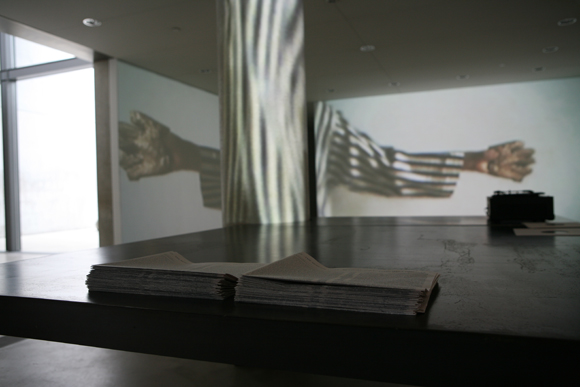
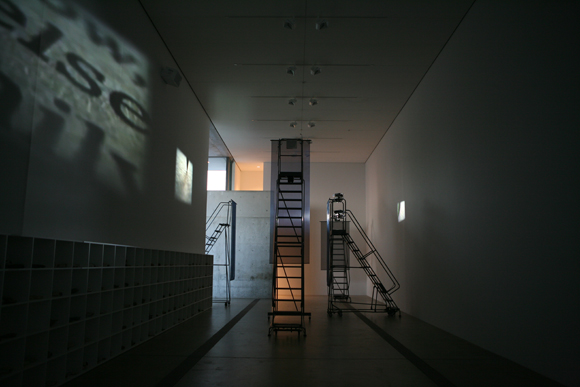
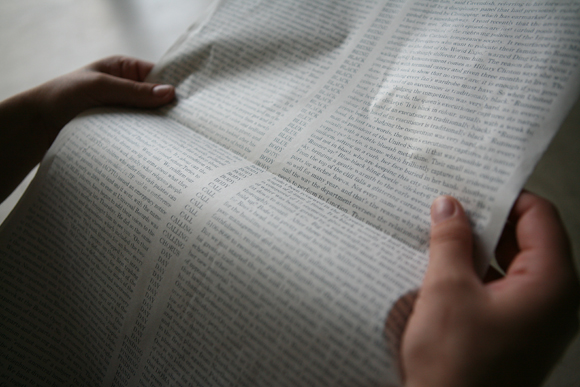
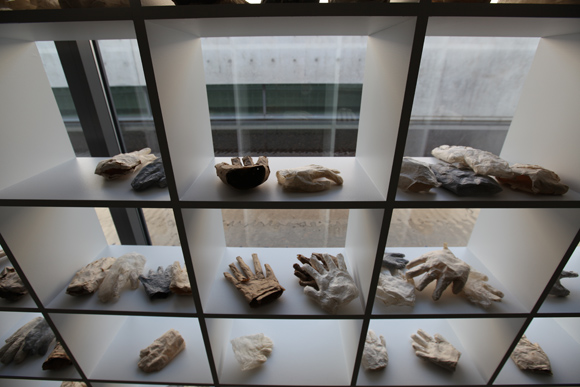
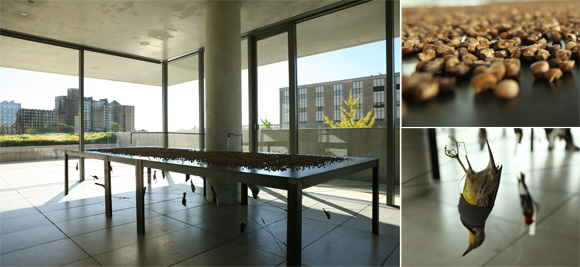
For a full illustrated floorplan of stylus, click here.
Photo credit: TOKY Branding + Design / Geoff Story / Jenny Fine
ACKNOWLEDGEMENTS
Special thanks to:
Sam Fox School of Design & Visual Arts at Washington University in St. Louis
St. Louis Public Library
St. Louis Public Schools
St. Louis Symphony
All Along Press
KDHX 88.1
Manic Design Studio
Opera Theatre of St. Louis
The Ohio State University
For a full list of participants who made stylus possible, click here.
 related: related:
· Seda-Reeder, Maria. "The Process of Reading Becomes an Act of Creation." http://www.aeqai.com (November 2010).
·
Wilson, Calvin. "Pulitzer space shares billing in new exhibit." http://www.stltoday.com (July 18, 2010).
· "Ann Hamilton: Pulitzer Foundation for the Arts." Artforum (January 2011). |






